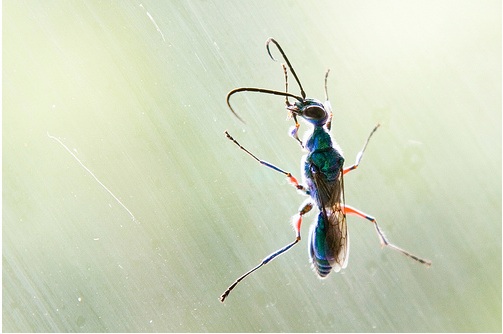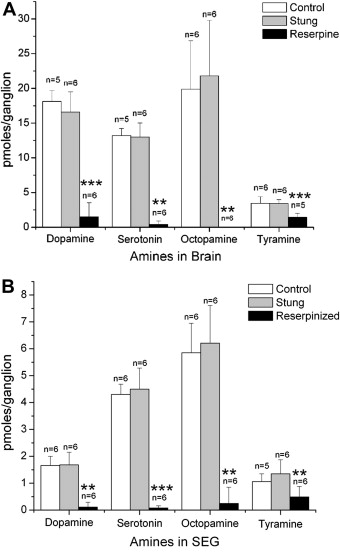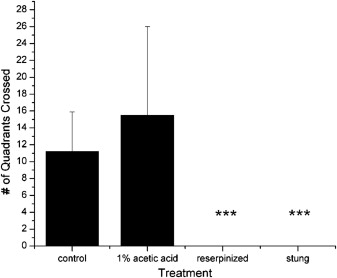Interactions

Ampulex compressa (the emerald cockroach wasp) relies almost completely on the American cockroach (Periplaneta americana) for both a food source and reproduction. The emerald cockroach is a solitary wasp (like the wasp species Sceliphron caementarium) and along with all other adult wasps, is unable to eat firm food but rather relies on sucking or drinking the hemolymph of the American cockroach and other insects that differ based on their differing locations (Bartlett 2004).
However, wasps are not only predators but prey as well. Some common predators of wasps include dragonflies (such as Somatochlora hineana), a very large variety of birds that vary by the location of the wasp but include tree swallows (Tachycineta bicolor), red-winged blackbirds (Agelaius phoeniceus), frogs such as the American bullfrog (Rana catesbeiana) and even other wasps.
Interactions with the American Cockroach
The emerald cockroach wasp has one of the most advanced known methods for disabling and utilizing its host. Although it is not uncommon for parasites to use their host for reproduction, the emerald cockroach wasp has a tactic that is unlike any other organisms’: a venomous sting directly to the brain that completely deteriorates the cockroach’s desire to escape. However, the cockroach isn’t paralyzed, without sensation, or dead but rather fully alive with motor functions intact. Only the cockroaches desire to escape from the wasp is changed.
What exactly happens to the cockroaches ganglia is still a
mystery. The state of a stung cockroach known as “hypokinesia” is
bizarre in that while the cockroach will not voluntarily move, it will
still regain its upward position if flipped on its back, groom
itself when it is aggravated by a stimulus and even swim when placed
in water. Banks, et al. conducted an experiment to test if this
strange behavior exhibited by a stung cockroach is due to a
lessening of biogenic amines in the cockroach’s central nervous
system. The test compared control cockroaches, cockroaches stung by
Ampulex compressa and cockroaches with decreased amines
(induced by reserpine, a sedative compound). The varied cockroaches
were placed into an arena where their physical activity was measured
by how many times they crossed quadrants over a 10 minute time
period. As expected, the control cockroach population had the
highest level of activity, crossing quadrants an average of 11.2 and
15.5 times in two separate tests. However, the reserpinized and stung cockroaches both
remained in their exact location with only a few slight turns on
their axis for the extent of the 10 minutes (Banks, et al. 2012).
Unfortunately, although both the reserpinized and stung cockroaches
behaved similarly in this test, when amine levels were evaluated in
the both the head and subesophageal ganglia it was found that the
stung cockroach population had a normal or even slightly higher than
average amine level than the control. The reserpinized cockroaches
had miniscule amounts of amines as expected, proving that a reduced
level of amines is not the cause for the hypokinesia state in stung
cockroaches. Other experiments have attempted to determine how
exactly the strange venom of the emerald cockroach wasp works, but
its true method can still only be hypothysized. Ampulex compressa
is truly amazing and unique in its techniques for immobilizing its host,
making it an incredibly successful parasitoid.
head and subesophageal ganglia it was found that the
stung cockroach population had a normal or even slightly higher than
average amine level than the control. The reserpinized cockroaches
had miniscule amounts of amines as expected, proving that a reduced
level of amines is not the cause for the hypokinesia state in stung
cockroaches. Other experiments have attempted to determine how
exactly the strange venom of the emerald cockroach wasp works, but
its true method can still only be hypothysized. Ampulex compressa
is truly amazing and unique in its techniques for immobilizing its host,
making it an incredibly successful parasitoid.
More about the experiments relating to the emerald cockroach wasps venom can be found through sciencedirect.com at Toxicon and Current Biology as well as A Wasp with a Taste for Brain.

